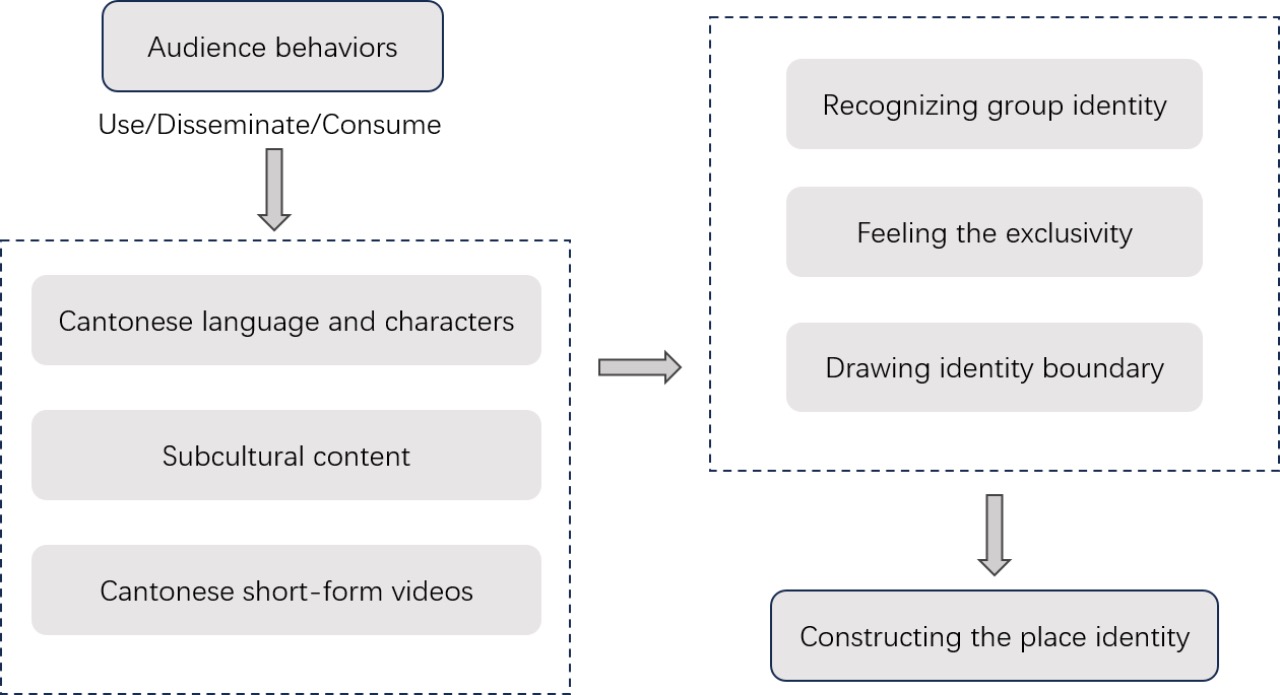A Study on the Audience of Cantonese Short-Form Video Content from the Perspective of Place Identity Theory
DOI:
https://doi.org/10.71113/JMSS.v2i4.389Keywords:
Place Identity, Local Culture, New Media, Short-form Video, AudienceAbstract
Dialect is a carrier for spreading local culture, an iconic symbol for recognizing local groups, and it is the foundation for the construction of place identity. Nowadays, Short videos have penetrated people's daily lives due to the development of new media technologies. As the most spoken unofficial language in China, Cantonese (also known as Yue Chinese) also has a special status in Chinese short video platforms. This study investigates Cantonese Short-form video audiences from the perspective of place identity theory, aiming to explore the relationship between Cantonese Short-form video content and the construction of place identity. Focusing on this theme, this study conducted semi-structured interviews with 19 Cantonese Short-form video content audiences and non-participatory observation on the short video platform Douyin to obtain qualitative data. The collected data were summarised using the thematic analysis method, and finally, three main themes were identified: the construction of boundaries, inheritance anxiety, and cultural integration. The study examines the paths and influences on the construction of place identity by audiences in the process of consuming Cantonese Short-form video content.
References
Bar-Adon, A. (1979). The Rise and Decline of a Dialect: A Study in the Revival of Hebrew. Berlin, Boston: De Gruyter Mouton.
Braun, V., & Clarke, V. (2006). Using thematic analysis in psychology. Qualitative research in psychology, 3(2), 77-101. https://doi.org/10.1191/1478088706qp063oa
Dixon, J., & Durrheim, K. (2004). Dislocating identity: Desegregation and the transformation of place. Journal of Environmental Psychology, 24, 455–473. https://doi.org/10.1016/j.jenvp.2004.09.004
Fleury-Bahi, G., Félonneau, M.-L., & Marchand, D. (2008). Processes of place identification and residential satisfaction. Environment and Behavior, 40, 669–682. https://doi.org/10.1177/0013916507307461
He, C. (2022). Cantonese short-form video: Current problems, aesthetic horizons and future implications of cultural production. Guangdong Sea Breeze, (4), 4–9. https://www.ncpssd.cn/Literature/articleinfo?id=YHF2022004002&synUpdateType=&type=journalArticle&typename=
Hong Kong University of Science and Technology (Guangzhou). (2024, September 6). GPS survey series: GPS+, beyond investigation. HKUST (GZ) News. https://www.hkust-gz.edu.cn/zh/news/hkust-gz-news
Jiang, B. (2006). Bilingualism and language harmony: A survey from Shanghai students' language use. Contemporary Rhetoric, (6), 64–66. https://doi.org/10.3969/j.issn.1674-8026.2006.06.021
Korpela, K. M. (1989). Place-identity as a product of environmental self-regulation. Journal of Environmental Psychology, 9, 241–256. https://doi.org/10.1016/S0272-4944(89)80038-6
Korpela, K. M. (2003). Negative mood and adult place preference. Environment & Behavior, 35, 331–346. https://doi.org/10.1177/0013916503251442
Kozinet, R. V. (1997). I Want to Believe: A Netnography of the X — philes Subculture of Consumption. Advances in Consumer Research, 24(1), 470—475.
Li, X., & Huang, B. (2019). Analysis of the characteristics of self-media short video communication. Today’s Mass Media, (5), 17–18. https://doi.org/10.3969/j.issn.1672-8122.2019.05.008
Peng,Y., & Ge, L., (2016). On the Interconstruction of Mandarin and Dialect. Journal of Jianghan University(Social Sciences Edition), 33(2), 28–34. https://doi.org/10.16387/j.cnki.42-1867/c.2016.02.005
Proshansky, H. M. (1978). The City and Self-Identity. Environment and Behavior, 10(2), 147-169., 10, 147–169. https://doi.org/10.1177/0013916578102002
Proshansky, H. M., Fabian, A. K., & Karminoff, R. (1983). Place identity: Physical world socialization of the self. Journal of Environmental Psychology, 3, 57–84. https://doi.org/10.1016/S0272-4944(83)80021-8
Relph, E. (1976). Place and Placelessness. London: Pion.
Roesch, K. A. (2012). Language maintenance and language death : the decline of Texas Alsatian / Karen A. Roesch. John Benjamins Pub. Co.
Sack, R. D. (1997). Homo Geographicus: a Framework for Action, Awareness, and Moral Concern. Baltimore, MD: Johns Hopkins University Press.
Sebba, M. (2003). Spelling rebellion. In J. Androutsopoulos & A. Georgakopoulou (Eds.), Discourse constructions of youth identities (pp. 151-172). John Benjamins. https://doi.org/10.1075/pbns.110.09seb
Shan, Y., & Li, S. (2018). Language attitudes of Guangzhou people and inheritance of Cantonese identity. Chinese Journal of Language Policy and Planning, 3(3), 34-41. https://doi.org/10.19689/j.cnki.cn10-1361/h.20180303
Tajfel, H. (1982). Social psychology of intergroup relations. Annual Review of Psychology, 33, 1–39. https://doi.org/10.1146/ANNUREV.PS.33.020182.000245
Tajfel, H., Billig, M. G., Bundy, R. P., & Flament, C. (1971). Social categorization and intergroup behaviour. European Journal of Social Psychology, 1(2), 149–178. https://doi.org/10.1002/ejsp.2420010202
Tuan, Y. F. (1977). Space and Place: The Perspective of Experience. Minneapolis, MN: University of Minnesota Press. https://archive.org/details/spaceplaceperspe0000tuan
Williams, D. R., & Roggenbuck, J. W. (1989). Measuring place attachment: Some preliminary results (Abstract). In Proceedings of the National Recreation and Parks Association Symposium on Leisure Research, 1989. San Antonio, TX, October 1989. Retrieved from https://www.researchgate.net/publication/242236220_Measuring_Place_Attachment_Some_Preliminary_Results
Yan, Z. (2019). An Analysis of the Audience Needs of the Cantonese Short Video YUE ZHI YI ER. Journalism Research Herald, 10(22), 60–61. https://doi.org/10.3969/j.issn.1674-8883.2019.22.029
Zhao, W. (2023). Research on the Participation Behavior Characteristics and Motivations of Cantonese Fandom Community on Bilibili from the Perspective of Participatory Culture [Master’s dissertation, South China University of Technology]. WanFangdata. https://d.wanfangdata.com.cn/thesis/ChhUaGVzaXNOZXdTMjAyNDA5MjAxNTE3MjUSCUQwMzMzMTQxNRoIdGN1bjlvOWk=
Zhu, X. (2011). Multidimensional origin of “Support Cantonese event”. The Journal of Chinese Sociolingui-stics, (2), 1–10. https://d.wanfangdata.com.cn/periodical/zgshyyx201102001

Downloads
Published
How to Cite
Issue
Section
License
Copyright (c) 2025 Ziyuan Liu

This work is licensed under a Creative Commons Attribution 4.0 International License.

















